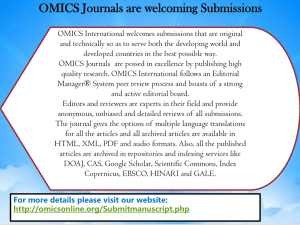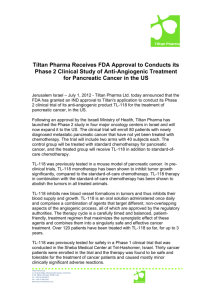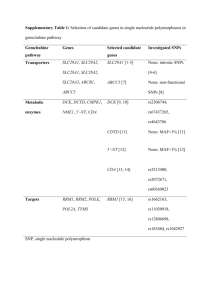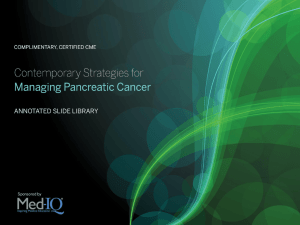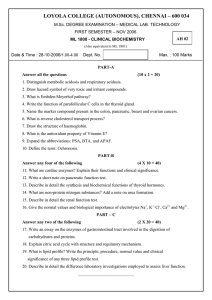TL-118—anti-angiogenic treatment in pancreatic
advertisement
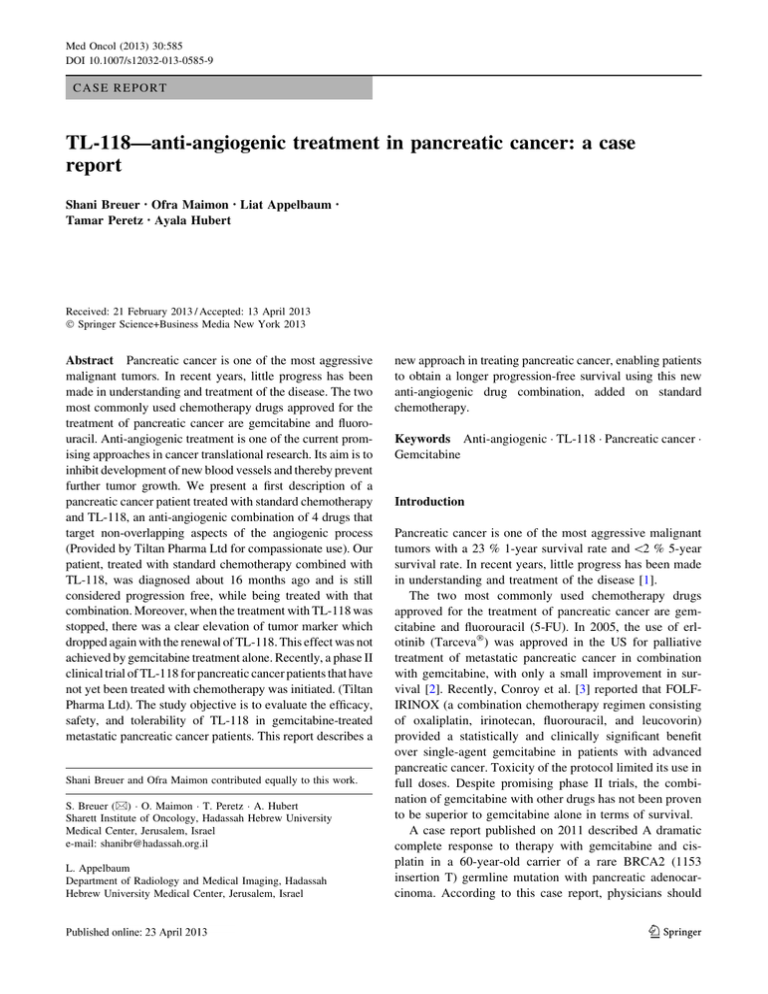
Med Oncol (2013) 30:585 DOI 10.1007/s12032-013-0585-9 CASE REPORT TL-118—anti-angiogenic treatment in pancreatic cancer: a case report Shani Breuer • Ofra Maimon • Liat Appelbaum Tamar Peretz • Ayala Hubert • Received: 21 February 2013 / Accepted: 13 April 2013 Ó Springer Science+Business Media New York 2013 Abstract Pancreatic cancer is one of the most aggressive malignant tumors. In recent years, little progress has been made in understanding and treatment of the disease. The two most commonly used chemotherapy drugs approved for the treatment of pancreatic cancer are gemcitabine and fluorouracil. Anti-angiogenic treatment is one of the current promising approaches in cancer translational research. Its aim is to inhibit development of new blood vessels and thereby prevent further tumor growth. We present a first description of a pancreatic cancer patient treated with standard chemotherapy and TL-118, an anti-angiogenic combination of 4 drugs that target non-overlapping aspects of the angiogenic process (Provided by Tiltan Pharma Ltd for compassionate use). Our patient, treated with standard chemotherapy combined with TL-118, was diagnosed about 16 months ago and is still considered progression free, while being treated with that combination. Moreover, when the treatment with TL-118 was stopped, there was a clear elevation of tumor marker which dropped again with the renewal of TL-118. This effect was not achieved by gemcitabine treatment alone. Recently, a phase II clinical trial of TL-118 for pancreatic cancer patients that have not yet been treated with chemotherapy was initiated. (Tiltan Pharma Ltd). The study objective is to evaluate the efficacy, safety, and tolerability of TL-118 in gemcitabine-treated metastatic pancreatic cancer patients. This report describes a Shani Breuer and Ofra Maimon contributed equally to this work. S. Breuer (&) O. Maimon T. Peretz A. Hubert Sharett Institute of Oncology, Hadassah Hebrew University Medical Center, Jerusalem, Israel e-mail: shanibr@hadassah.org.il L. Appelbaum Department of Radiology and Medical Imaging, Hadassah Hebrew University Medical Center, Jerusalem, Israel new approach in treating pancreatic cancer, enabling patients to obtain a longer progression-free survival using this new anti-angiogenic drug combination, added on standard chemotherapy. Keywords Anti-angiogenic TL-118 Pancreatic cancer Gemcitabine Introduction Pancreatic cancer is one of the most aggressive malignant tumors with a 23 % 1-year survival rate and \2 % 5-year survival rate. In recent years, little progress has been made in understanding and treatment of the disease [1]. The two most commonly used chemotherapy drugs approved for the treatment of pancreatic cancer are gemcitabine and fluorouracil (5-FU). In 2005, the use of erlotinib (TarcevaÒ) was approved in the US for palliative treatment of metastatic pancreatic cancer in combination with gemcitabine, with only a small improvement in survival [2]. Recently, Conroy et al. [3] reported that FOLFIRINOX (a combination chemotherapy regimen consisting of oxaliplatin, irinotecan, fluorouracil, and leucovorin) provided a statistically and clinically significant benefit over single-agent gemcitabine in patients with advanced pancreatic cancer. Toxicity of the protocol limited its use in full doses. Despite promising phase II trials, the combination of gemcitabine with other drugs has not been proven to be superior to gemcitabine alone in terms of survival. A case report published on 2011 described A dramatic complete response to therapy with gemcitabine and cisplatin in a 60-year-old carrier of a rare BRCA2 (1153 insertion T) germline mutation with pancreatic adenocarcinoma. According to this case report, physicians should 123 Page 2 of 4 consider BRCA mutation testing when the diagnosis of pancreatic cancer is established, especially when the patient belongs to an ethnic group where founder mutations exist, and/or there is strong personal or family history of cancer [4]. Anti-angiogenic treatment is one of the current promising approaches in cancer translational research. Its aim is to inhibit development of new blood vessels that deliver oxygen and nutrients to the tumor and thereby prevent further tumor growth. Anti-angiogenic treatment also ostensibly reduces the development of resistance to standard chemotherapy [5]. Several agents and drugs were described in the literature as having an anti-angiogenic effect. Results from a phase III trial indicate that the addition of the bevacizumab (a targeted therapy that blocks VEGF, which plays a key role in the development of angiogenesis) to gemcitabine does not improve survival in advanced pancreatic cancer [6]. We present a first description of a pancreatic cancer patient treated with standard chemotherapy and TL-118, an anti-angiogenic combination of 4 drugs that target nonoverlapping aspects of the angiogenic process (Provided by Tiltan Pharma Ltd for compassionate use). TL-118 has demonstrated anti-angiogenic activity in animal models [15] and in pancreatic cancer models (Tiltan Pharma Ltd, unpublished data). Med Oncol (2013) 30:585 After recovering from the stent insertion, in July 2011, palliative chemotherapy was initiated with gemcitabine and TL-118 (gemcitabine 1,000 mg/m2 day 1, 8, 15 Q = 28 days). CT scan 2 months later showed reduction in the pancreatic lesion but demonstrated new periportal changes suspicious for malignancy involvement. Positron emission tomography (PET) at that area showed the maximum standardized uptake value of 4.7 suv, which was most probably related to the stent. No other pathological uptakes were seen. After 3 months of treatment, in October 2011, tumor marker CA 19-9 went down to 60 l/ml, bilirubin was at normal levels, and the patient was free of pain. This clinical improvement was recognized at the imaging tests. Surveillance MRCP and CT scans were performed after 6 and 8 months, respectively, from the initiation of treatment. These tests revealed dramatic decrease in size of the lesion with almost complete remission—a discrete mass was no longer identified, replaced by mild soft tissue infiltration (Fig. 1). Case description A 75-year-old female was diagnosed with inoperable carcinoma of the pancreas presented with abdominal pain and weight loss (8 kg during 2 months). Physical examination revealed upper left quadrant pain and jaundice. No palpable mass, no hepatosplenomegaly. Laboratory examination findings were as follows: serum liver enzymes were elevated—ALT 242 l/l, AST 132 l/l, ALK-P 608 l/l, GGT 418 l/l, and total bilirubin 234 mg/dl. The synthetic functions, such as INR and albumin, remain normal. Serum tumor marker CA 19-9 was 1,806 u/ml, and CEA was normal. Computed tomography (CT) showed an enhancing 4.7 cm pancreatic head mass, with intra- and extrahepatic biliary dilatation, common bile duct measuring 15 mm. The SMV (superior mesenteric vein) was obstructed and encased within the tumor and therefore the patient was inoperable. The patient underwent percutaneous transhepatic cholangiogram and stent was inserted into the common bile duct (CBD) in order to drain the biliary tract. Recurrent attempts to achieve tissue diagnosis were unsuccessful, and due to clinical manifestation, tumor marker and evidence of pancreatic mass on imaging, it has been decided to treat the patients without pathological verification. 123 Fig. 1 Computed tomography (CT scan) during treatment with TL118: a July 2011, beginning of treatment. b April 2012 Med Oncol (2013) 30:585 Page 3 of 4 On January 2012, the treatment with TL-118 was put on hold due to side effects, mainly weakness and vomiting, and the patient was treated with gemcitabine alone until April 2012. Between April and June, the patient did not receive any treatment because of cholangitis and stent replacement. During that time, on May 2012, tumor marker CA 19-9 was elevated to 90 l/ml. At that point, gemcitabine treatment was renewed but tumor marker level continued to rise up to CA 19-9 of 1,171 l/ml on October 2012. TL-118 treatments were then resumed and this mode of treatment led to clinical improvement and drastic tumor marker reduction to CA 19-9 of 345 l/ml a month after renewal of TL-118 (Fig. 2). At the time of writing, 16 months post-diagnoses, the patient is still receiving this TL-118 treatment and continues to be stable. Discussion The average progression-free survival and overall survival for patients treated with first-line chemotherapy for pancreatic cancer is approximately 6 and 9 months respectively. Our patient, treated with standard chemotherapy combined with TL-118, was diagnosed about 16 months ago and is still considered progression free (partial, near complete response which is stable)—compared to baseline, while being treated with that combination. Moreover, when the treatment with TL-118 was stopped, there was a clear elevation of tumor marker which dropped again with the renewal of TL-118. This effect was not achieved by gemcitabine treatment alone. Angiogenesis is the process where growth of new blood vessels from pre-existing vessels enables the tumor to grow and send metastases [5, 7]. TL-118 is a novel drug combination that takes into consideration multisteps of the angiogenic process. Its active components are as follows: (1) cimetidine (antihistamine) which has an anti-angiogenic effect probably via the inhibition of mast cells activity [10–12]; (2) metronomic cyclophosphamide (alkylating agent) which drives tumor endothelial cell apoptosis [5];(3) diclofenac (nonsteroidal anti-inflammatory drug) that affects monocytes and other inflammatory cells which are essential at the onset of the angiogenic process [8, 9, 11, 13], and (4) sulfasalazine, a NF kappa B inhibitor that inhibits angiogenesis [14]. TL-118 is supplied as an oral liquid for daily administration and can be administered at home. Concomitantly, gemcitabine is given as the standard of care—1,000 mg/m2 on day 1, 8, 15 every 28 days, while TL-118 is started on day two of the first chemotherapy and then continued every day. As described, each of the TL-118 components is shown to have some anti-angiogenic activity. There is no known contraindication in concurrent administration, and all four components are approved drugs for diverse indications. Regarding side effects, all but one are non-cytotoxic agents. The rationale behind this protocol is twofold: (a) treatment with a combination of a few drugs, each directed against different component of angiogenesis may result in a synergistic effect, with the ability to use lower doses of each component, (b) the combination of anti-angiogenic activity of TL-118 with standard chemotherapy has a Gemcitabine TL - 118 Beginning of treatment TL – 118 + Gemcitabine Gemcitabine TL -118 Section of TL – 118 Renewal of TL – 118 Fig. 2 CA 19-9 levels during treatment with TL-118 123 Page 4 of 4 potential for significant suppression of tumor growth. This was demonstrated in a pre-clinical trial that examined the efficacy of this combination in an orthotropic pancreatic cancer model in mice. In that study, mice were given gemcitabine with or without TL-118. Mice that were treated with the combination were all tumor free and no significant changes in body weight was showed as a result of the combination therapy. Also, TL-118 showed promising results with comparison to standard chemotherapy even as a monotherapy (unpublished data). A recent publication by Edrei et al. [15] evaluated the therapeutic potential of TL-118 in mice with metastatic colorectal cancer, compared with B20—an anti-VEGF antibody or rapamycin (another anti-angiogenic immunosuppressant drug). The study showed outstanding prolongation of survival and demonstrated major effect on metastasis perfusion and vessel density. A few mechanisms were shown to contribute to those results, among them reduction in nitric oxide (NO) serum levels and hepatic perfusion attenuation. Phase II clinical trials evaluating the safety and efficacy of TL-118 in metastatic prostate cancer is ongoing since 2009. Recently, a phase II clinical trial of TL-118 for pancreatic cancer patients that have not yet been treated with chemotherapy was initiated (Tiltan Pharma Ltd). The study objective is to evaluate the efficacy, safety, and tolerability of TL-118 in gemcitabine-treated metastatic pancreatic cancer patients. The clinical trial will enroll 80 patients—40 in the treatment arm and 40 in the control arm—treated only with gemcitabine. This report describes a new approach in treating pancreatic cancer, enabling patients to obtain a longer progression-free survival using this new anti-angiogenic drug combination, added on standard chemotherapy. Conflict of interest We declare that TL-118, an anti-angiogenic treatment, was provided by Tiltan Pharma Ltd for compassionate use. Med Oncol (2013) 30:585 3. 4. 5. 6. 7. 8. 9. 10. 11. 12. 13. 14. References 1. Hidalgo M. Pancreatic cancer. N Engl J Med. 2010;362(17): 1605–17. 2. Moore MJ, Goldstein D, Hamm J, Figer A, Hecht JR, Gallinger S, Au HJ, Murawa P, Walde D, Wolff RA, Campos D, Lim R, Ding K, Clark G, Voskoglou-Nomikos T, Ptasynski M, Parulekar W, 123 15. National Cancer Institute of Canada Clinical Trials Group. Erlotinib plus gemcitabine compared with gemcitabine alone in patients with advanced pancreatic cancer: a phase III trial of the National Cancer Institute of Canada Clinical Trials Group. J Clin Oncol. 2007;25(15):1960–6. Conroy T, Desseigne F, Ychou M, Bouché O, Guimbaud R, Bécouarn Y, Adenis A, Raoul JL, Gourgou-Bourgade S, de la Fouchardière C, Bennouna J, Bachet JB, Khemissa-Akouz F, Péré-Vergé D, Delbaldo C, Assenat E, Chauffert B, Michel P, Montoto-Grillot C, Dhauffert B. FOLFIRINOX versus gemcitabine for metastatic pancreatic cancer. N Engl J Med. 2011;364: 1817–25. Sonnenblick A, Kadouri L, Appelbaum L, Peretz T, Sagi M, Goldberg Y, Hubert A. Complete remission, in BRCA2 mutation carrier with metastatic pancreatic adenocarcinoma, treated with cisplatin based therapy. Cancer Biol Ther. 2011;12(3):165–8. (Epub 2011 Aug 1). Browder T, Butterfield CE, Kräling BM, Shi B, Marshall B, O’Reilly MS, Folkman J. Antiangiogenic scheduling of chemotherapy improves efficacy against experimental drug-resistant cancer. Cancer Res. 2000;60(7):1878–86. Kindler HL, Niedzwiecki D, Hollis D, Sutherland S, Schrag D, Hurwitz H, Innocenti F, Mulcahy MF, O’Reilly E, Wozniak TF, Picus J, Bhargava P, Mayer RJ, Schilsky RL, Goldberg RM. Gemcitabine plus bevacizumab compared with gemcitabine plus placebo in patients with advancedpancreatic cancer: phase III trial of the Cancer and Leukemia Group B (CALGB 80303). J Clin Oncol. 2010;28(22):3617–22. Meyers MO, Watson JC. Angiogenesis and hepatic colorectal metastases. Surg Oncol Clin N Am. 2003;12(1):151–63. Murphy JF, Steele C, Belton O, Fitzgerald DJ. Induction of cyclooxygenase-1 and -2 modulates angiogenic responses to engagement of alphavbeta3. Br J Haematol. 2003;121(1):157–64. Sawaoka H, Tsuji S, Tsujii M, Gunawan ES, Sasaki Y, Kawano S, Hori M. Cyclooxygenase inhibitors suppress angiogenesis and reduce tumor growth in vivo. Lab Invest. 1999;79(12):1469–77. Burtin C, Noirot C, Scheinmann P, Galoppin L, Sabolovic D, Bernard P. Clinical improvement in advanced cancer disease after treatment combining histamine and H2-antihistaminics (ranitidine or cimetidine). Eur J Cancer Clin Oncol. 1988;24(2):161–7. Siegers CP, Andresen S, Keogh JP. Does cimetidine improve prospects for cancer patients? A reappraisal of the evidence to date. Digestion. 1999;60(5):415–21. Natori T, Sata M, Nagai R, Makuuchi M. Cimetidine inhibits angiogenesis and suppresses tumor growth. Biomed Pharmacother. 2005;59(1–2):56–60. Mayorek N, Naftali-Shani N, Grunewald M. Diclofenac inhibits tumor growth in a murine model of pancreatic cancer by modulation of VEGF levels and arginase activity. PLoS ONE. 2010;5(9):e12715. Weber CK, Liptay S, Wirth T, Adler G, Schmid RM. Suppression of NF-kappaB activity by sulfasalazine is mediated by direct inhibition of IkappaB kinases alpha and beta. Gastroenterology. 2000;119(5):1209–18. Edrei Y, Gross E, Corchia N, Abramovitch R. Improved efficacy of a novel anti-angiogenic drug combination (TL-118) against colorectal-cancer liver metastases; MRI monitoring in mice. Br J Cancer. 2012;107(4):658–66.
